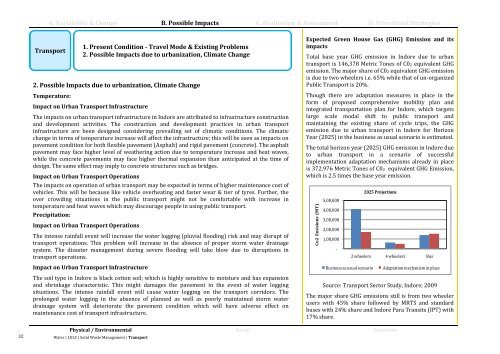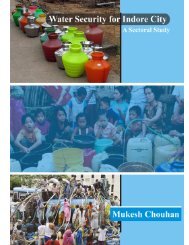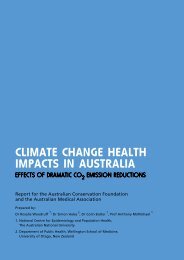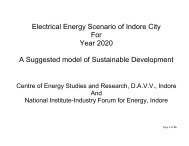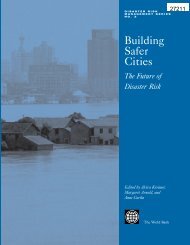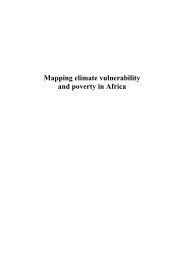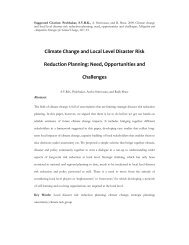Indore City Resilience Strategy - ImagineIndore.org
Indore City Resilience Strategy - ImagineIndore.org
Indore City Resilience Strategy - ImagineIndore.org
Create successful ePaper yourself
Turn your PDF publications into a flip-book with our unique Google optimized e-Paper software.
Co2 Emisions (MT)<br />
A. Variability & Change B. Possible Impacts C. Evaluation & Assessment D. Prioritized Strategies<br />
Transport<br />
2. Possible Impacts due to urbanization, Climate Change<br />
Temperature:<br />
Impact on Urban Transport Infrastructure<br />
The impacts on urban transport infrastructure in <strong>Indore</strong> are attributed to infrastructure construction<br />
and development activities. The construction and development practices in urban transport<br />
infrastructure are been designed considering prevailing set of climatic conditions. The climatic<br />
change in terms of temperature increase will affect the infrastructure; this will be seen as impacts on<br />
pavement condition for both flexible pavement (Asphalt) and rigid pavement (concrete). The asphalt<br />
pavement may face higher level of weathering action due to temperature increase and heat waves,<br />
while the concrete pavements may face higher thermal expansion than anticipated at the time of<br />
design. The same effect may imply to concrete structures such as bridges.<br />
Impact on Urban Transport Operations<br />
The impacts on operation of urban transport may be expected in terms of higher maintenance cost of<br />
vehicles. This will be because like vehicle overheating and faster wear & tier of tyres. Further, the<br />
over crowding situations in the public transport might not be comfortable with increase in<br />
temperature and heat waves which may discourage people in using public transport.<br />
Precipitation:<br />
1. Present Condition - Travel Mode & Existing Problems<br />
2. Possible Impacts due to urbanization, Climate Change<br />
Impact on Urban Transport Operations<br />
The intense rainfall event will increase the water logging (pluvial flooding) risk and may disrupt of<br />
transport operations. This problem will increase in the absence of proper storm water drainage<br />
system. The disaster management during severe flooding will take blow due to disruptions in<br />
transport operations.<br />
Expected Green House Gas (GHG) Emission and its<br />
impacts<br />
Total base year GHG emission in <strong>Indore</strong> due to urban<br />
transport is 146,378 Metric Tones of C02 equivalent GHG<br />
emission. The major share of C02 equivalent GHG emission<br />
is due to two wheelers i.e. 65% while that of un-<strong>org</strong>anized<br />
Public Transport is 20%.<br />
Though there are adaptation measures in place in the<br />
form of proposed comprehensive mobility plan and<br />
integrated transportation plan for <strong>Indore</strong>, which targets<br />
large scale modal shift to public transport and<br />
maintaining the existing share of cycle trips, the GHG<br />
emission due to urban transport in <strong>Indore</strong> for Horizon<br />
Year (2025) in the business as usual scenario is estimated.<br />
The total horizon year (2025) GHG emission in <strong>Indore</strong> due<br />
to urban transport in a scenario of successful<br />
implementation adaptation mechanisms already in place<br />
is 372,976 Metric Tones of C02 equivalent GHG Emission,<br />
which is 2.5 times the base year emission.<br />
5,00,000<br />
4,00,000<br />
3,00,000<br />
2,00,000<br />
1,00,000<br />
-<br />
2025 Projections<br />
2 wheelers 4 wheelers Bus<br />
Impact on Urban Transport Infrastructure<br />
Business as usual scenario<br />
Adaptation mechanism in place<br />
The soil type in <strong>Indore</strong> is black cotton soil; which is highly sensitive to moisture and has expansion<br />
and shrinkage characteristic. This might damages the pavement in the event of water logging<br />
situations. The intense rainfall event will cause water logging on the transport corridors. The<br />
prolonged water logging in the absence of planned as well as poorly maintained storm water<br />
drainage system will deteriorate the pavement condition which will have adverse effect on<br />
maintenance cost of transport infrastructure.<br />
Source: Transport Sector Study, <strong>Indore</strong>; 2009<br />
The major share GHG emissions still is from two wheeler<br />
users with 45% share followed by MRTS and standard<br />
buses with 24% share and <strong>Indore</strong> Para Transits (IPT) with<br />
17% share.<br />
32<br />
Physical / Environmental Social Economic<br />
Water | LULC | Solid Waste Management | Transport


